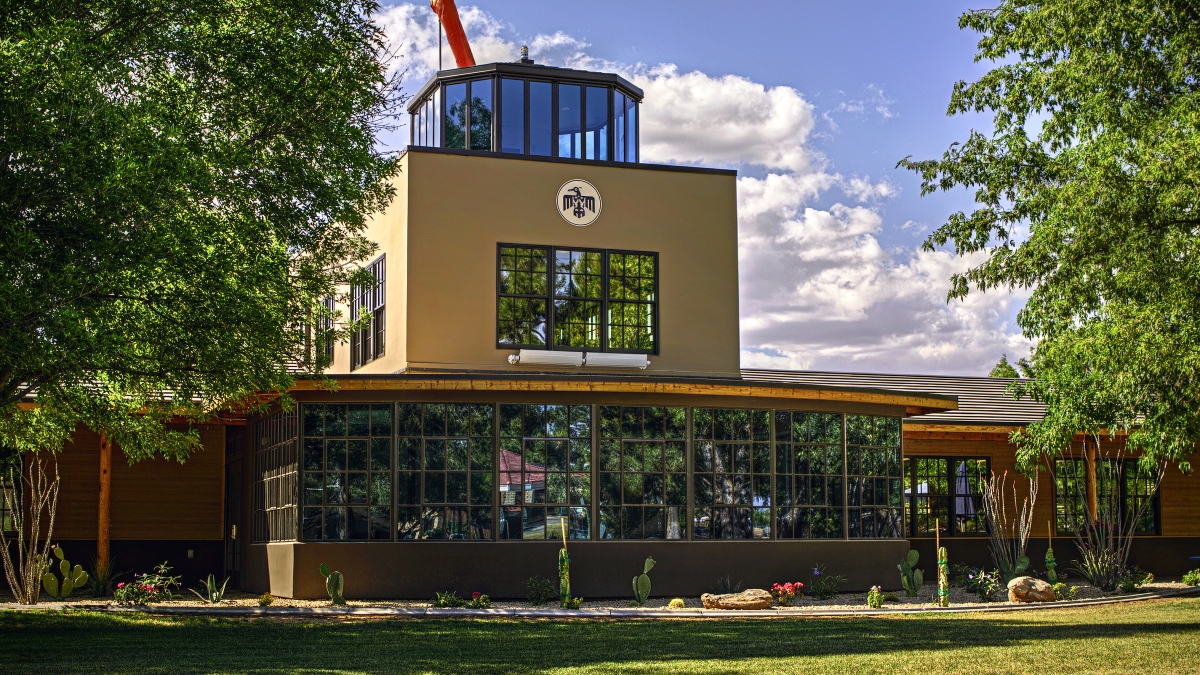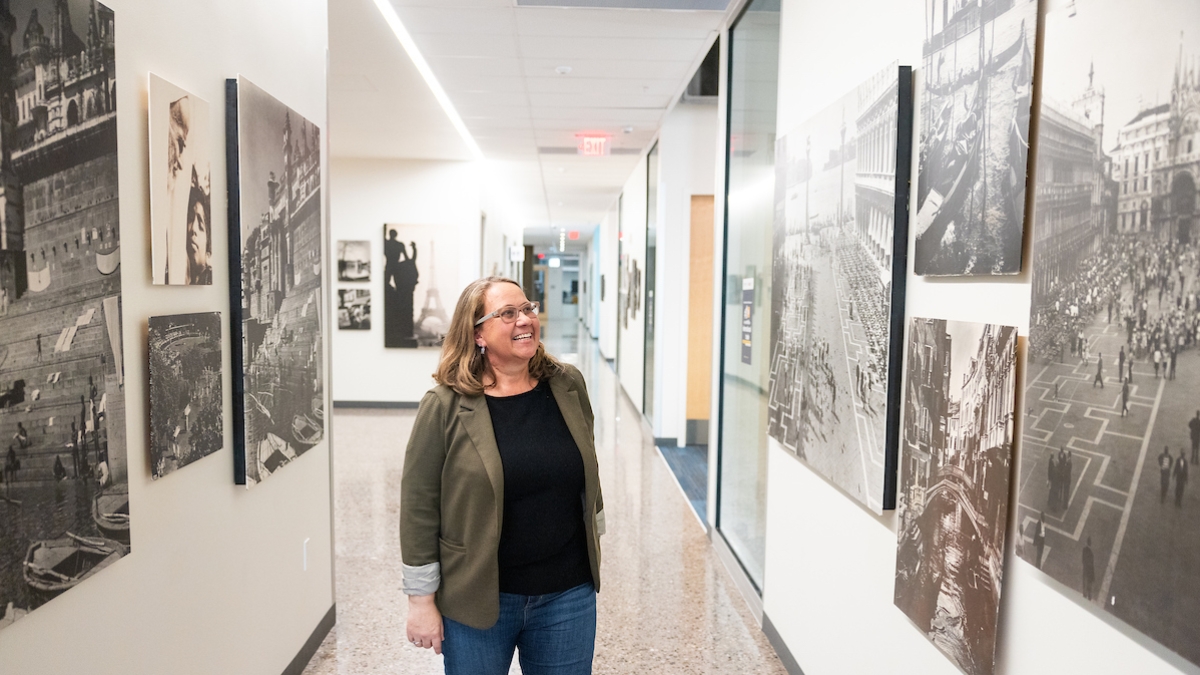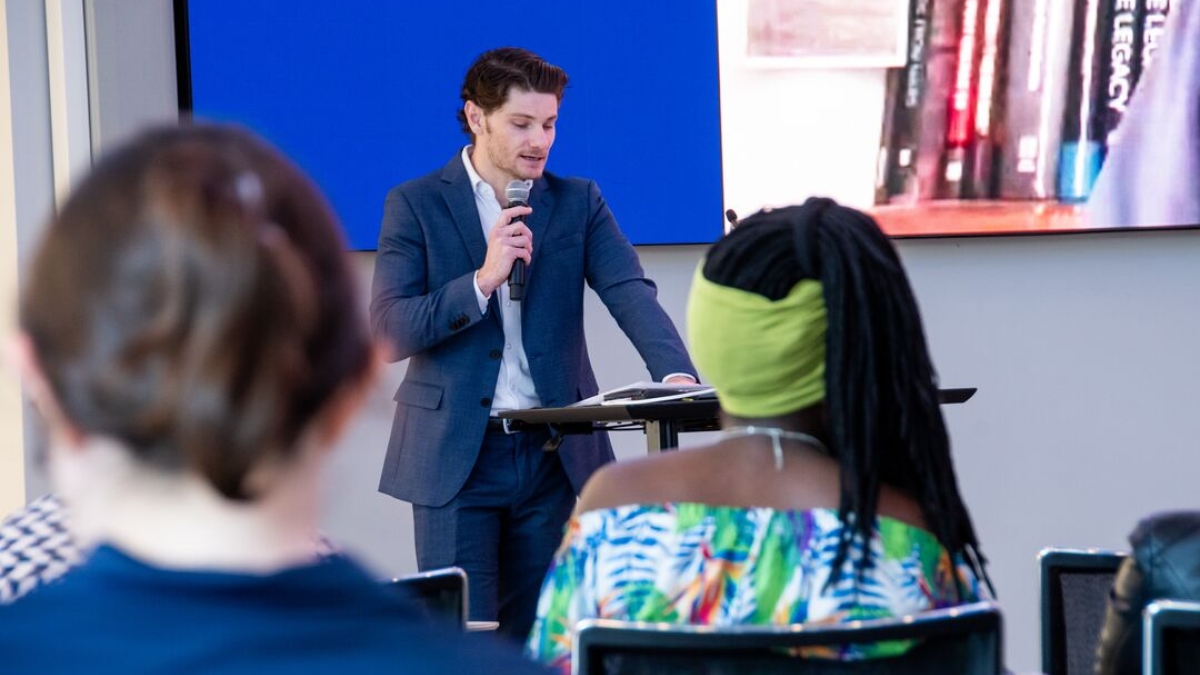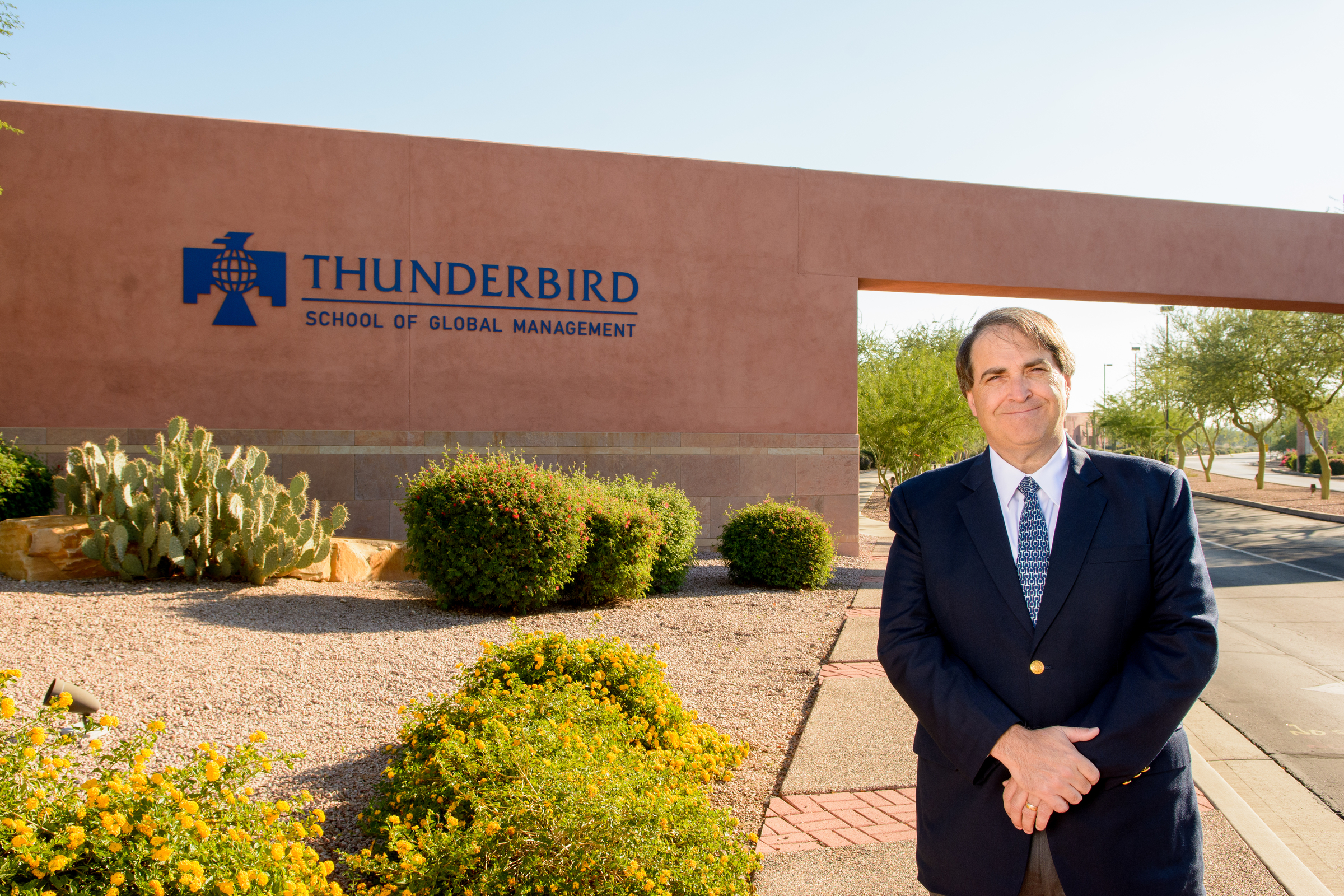In war and peace, Thunderbird School is all business
Graduate school transforms from air field to ASU campus

Editor's note: This story is being highlighted in ASU Now's year in review. To read more top stories from 2015, click here.
In 1941, men came to a dusty plot of land in Glendale to learn how to fight their enemies.
The war had been raging for two years overseas and the Americans knew they’d soon be in it.
Over the next four years, more than 15,000 pilots trained at Thunderbird Field before going off to fight in World War II.
Then the war ended, and by 1946, the patch of desert was transformed from a place where men were taught to battle foreign foes to a school where they learned how to be global citizens.
The control tower that once guided fighter pilots now looked over a brand-new business school, the American Institute for Foreign Trade.
The barracks became dormitories and the runways were used as campus footpaths.
During the institute's first few years, almost all the students were male veterans, studying under the GI Bill, who hoped to work abroad.
And by the 1950s, the economy was booming with so many jobs that companies tried to lure the men away while they were still taking classes. American Express, Goodyear Tire and Rubber and the National Bank of New York all recruited heavily from the school for their international operations.
“Then, it was the only school of its kind where people were studying to go overseas,” said Dean Warner, a graduate of the class of 1957 of what is now the Thunderbird School of Global Management.
In its 70 years, Thunderbird grew from a small trade school to a bustling center of graduate education that drew thousands of students from around the world. Alumni were fiercely proud and formed groups in more than 100 countries.
But by the late 1990s, the Internet began to shrink the world. People could earn degrees online and companies didn’t have to send employees overseas to do international business. Fewer students came to Thunderbird, and the school needed to find a new model to continue operating in changed circumstances. In 2014, Thunderbird became a unit of Arizona State University.
Its passionate alumni are relieved that the school was saved, but hope that Thunderbird can keep the unique identity that it forged in those post-war years, when anything was possible.
Because, as Warner recalls, “There was nothing else like it back then.”
‘Keep 'em flying!’
Thunderbird was born for business. In 1940, that business was war.
Before the U.S. even joined the fight, a group of Hollywood investors formed a corporation called Southwest AirwaysThe business has no relation to the present-day commercial company Southwest Airlines.. They found a patch of land in the Glendale desert and told the Army that if it put an air base there, they would run it and produce pilots for the battles everyone knew were coming.
The spot was perfect for pilot training — remote with excellent weather and nearly endless visibility.
Construction started in January 1941 and by March the first group of 57 Army Air Force cadets arrived for 10 weeks of primary flight trainingThe “Thunderbird Annual” lists their names and hometowns — almost all small towns in Kansas and Missouri.. The barracks were only half done and the runways were still being graded but the cadets got right to it.
The base motto was “Keep 'Em Flying.”
The cadets’ supervisors were military officers, but everything else at the base was run by civilian employeesAbout a quarter of these were women. A monthly company magazine from 1943 included a “Strictly Feminine” page that had the headline “Girls handle man-sized jobs.” Another issue announced a woman flight “instructress” at Sky Harbor, described as a “pretty, young wife … .” of Southwest Airways — flight instructors, field personnel and maintenance workers.
Operations quickly ramped up. Class after class of cadets flowed in. Instruction was held seven days a week.
Thunderbird was one of four military-training air fields that Southwest Airways operated in the Valley. The others were Sky Harbor, Thunderbird Field Two, which later became Scottsdale Airport, and Williams Field in Mesa.
In the first year, the cadets were Americans, but soon the field started accepting traineesThunderbird training included 65 hours of flying and 275 takeoffs and landings. from the Chinese Air Force. Pilots from the United Kingdom's Royal Air Force studied at Thunderbird for several months before their training was moved to Falcon Field.
The conditions were not luxurious.

Thunderbird Field trained pilots from 1941 to 1945. Photo courtesy of Thunderbird School of Global Management Archives, ASU Libraries
A brochure sent to parents at the time titled “Your Cadet” said: “On Arizona's hot summer days, an evaporative cooling unit reduces the temperature to 85 degrees in his room.”
When it rained, the slats on the beds warped and the mattresses would fall to the floor. The runways became pot-holed mud fields.
But the young men didn’t starve. Thunderbird went through 65,000 pounds of meat and 25 truckloads of vegetables a month.
After four years, the tide turned, the war wound down and the cadets stopped coming. By the fall of 1945, the field sat vacant.
In 1946, Thunderbird’s business became peace.
Saturday night dances
At the end of the war, two retired Army colonels thought of a novel idea: Use the old base as a school to train businessmen to work in other countries. They pitched their idea to Barton Kyle Yount, a retired lieutenant general who jumped aboard.
But first, he needed to get the land from the Army.
The property was assessed at more than $407,000, but because he promised to create a school, Yount got the land for free. That giveaway of war surplus property prompted a brief congressional investigation. The hearings exonerated Yount but the flurry of nationwide attention raised the profile of the new school, which was flooded with applicants. The first graduating class in June 1947 had 234 students from 45 states.
While the school drew hundreds of students, the site was still rural, surrounded by fields.
“In the harvest time, it smelled like onions,” Warner said. “We would go into Glendale or Phoenix on the weekends. There was a beer joint on Glendale Avenue but that was it.”
Warner had gotten his undergraduate degree in Mexico and knew he wanted to work overseas. He saw an article in “Arizona Highways” magazine about the American Institute for Foreign Trade and decided to enroll.
“It was very different from what it is now. The professors were mostly retired businesspeople, not academics. They were successful businesspeople but the classes were taught at a fairly elementary level compared to now,” he said.
William Schurz was a beloved faculty member who served briefly as president. He was an expert on Latin America and traveled more than 27,000 miles along the Amazon, Warner recalled.
“He was really an Indiana Jones kind of person. He would lecture with no notes and he was just amazing,” Warner said.
“It’s a place that grows on you and you grow to love it after you get over the initial shock. And I mean that with affection.” — Kevin Rohrer, Thunderbird alumni
It was Schurz who uttered the phrase that became the school’s mission: “Borders frequented by trade seldom need soldiers.”
Students were immersed in cultural studies. They sung in the French chorus and learned to tango at the Saturday night dance club called El Botecito. Christmas was celebrated in a Latin American way, called “La Posadas.” Chopsticks were used during “Asia Night” in the dining hall. Ambassadors, foreign presidents and other dignitaries visited to talk to the students.
The school began to grow and add buildings, with the Tower Building expanded in 1960 and the campus' beloved pub added in 1971. The Frank Snell Learning Center went up in 1981. And by 1990 the onion fields had given way to endless development, when about enrollment ballooned to 1,500 students.
But the campus has never been fancy — and the students bonded over that.
“When I was there, it was still a little rough around the edges. You could tell some of the dorms were former barracks,” said Kevin Rohrer, who graduated in 1982.
“It’s a place that grows on you and you grow to love it after you get over the initial shock. And I mean that with affection.”
Rohrer said the language and cultural studies were important to his success as an American business owner in Hong Kong, but the non-classroom interactions were also crucial.
“There were a lot of people like me,” he said. “Some people wanted to work for big banks and major financial centers but there were also people doing marketing and who wanted to start their own business.
“Being around people with similar aspirations and meeting alums who followed their dreams really inspires you to give it a shot.”
The alumni maintain a strong network of 170 groups in 140 countries.
“Thunderbirds are very social, and there’s just something in our personality,” Rohrer said.
Many alumni are drawn back to the school.
After graduating, Warner went to work for a mining in company in Peru before starting his own business dealing in artifacts and folk art. After decades of travelling the world, he returned to Thunderbird in the early 1990s as a consultant, curating the school’s art and creating the Global Market, which is now the ThunderShop store. Much of the art in the International Business Information Centre was donated by Warner.
Rohrer was head of the alumni association and was a member of the board of trustees in 2014.
The alumni connections are crucial: About 70 percent of students come to Thunderbird because of contact with a graduate of the school.
One of those is Neha Bandekar, 26, a current student from India. When she expressed interest in pursuing a degree in global management, her brother-in-law, a Thunderbird alum, told her, “This is the school to go to.”
She visited the campus last spring when Thunderbird’s status as part of a larger university was new, and later she attended a networking event at a Thunderbird alumni group in India, where everyone welcomed her. Any hesitation she may have had disappeared that night.
“Every one of them was so proud, it was so beautiful,” she said. “All my doubts went away then and there.”
She has no regrets.
“This is a place when you deal with the real world,” she said. “In one class, it’s like a melting pot. I have students from 23 countries. I get to know their cultures, and it’s like a family.”
‘A new way of thinking’
Allen Morrison became CEO and director general on Jan. 1, 2015, the day that Thunderbird’s partnership with ASU became official.
He inherited an institution in transition.
Despite an international reputation, the previous two years had been a difficult time at Thunderbird.
The board of trustees had voted in 2013 to sell Thunderbird to Laureate, a company that runs for-profit tutoring centers.
Many alumni were furious.
They feared the move would tarnish their prestigious degrees and lead to the demise of their beloved school. Four trustees quit the board.
The accrediting body ultimately rejected the plan in 2014 and that’s when negotiations with ASU began, culminating in a deal in December.
Allen Morrison, CEO and director general of Thunderbird School of Global Management.
Morrison has worked for 11 months building connections with alumni around the United States, in Europe, Asia and South America.
Morrison said that ASU values the unique nature of the school, which loyalists call “the Thunderbird mystique.”
“At the same time, there is an appreciation that Thunderbird, by itself, does not have the scale or scope to meet its full potential,” he said.
ASU is helping with that. For example, the school has already begun using ASU faculty to design and teach some executive education courses. Thunderbird is ranked seventh in world for its corporate-training programs — a major source of revenue that Morrison hopes to greatly expand.
Also, new this year, Thunderbird has launched an undergraduate degree, which will award a bachelor’s in global management, with classes held on ASU’s West campus.
Morrison said that one way he’s re-engaged the Phoenix-area graduates is by starting a mentoring program that pairs local alumni with current students, many of whom are from other countries. The mentors help the students adjust to American culture and learn about business practices in the U.S.
The Glendale campus has about 300 full-time students now and one urgent goal is increasing enrollment. On his world tour, Morrison visited several universities he would like to partner with as feeder schools to Thunderbird.
“We’re interested not in increasing the percentages of students from a particular country. We’re more interested in increasing the quality of our students from all countries,” he said.
Morrison has emphasized those global ties because while about 60 percent of Thunderbird’s graduates go on to work in the business world, the rest work for governments, non-profit organizations and other international institutions.
Today, Thunderbird’s control tower overlooks a hangar that’s tied to the past as well as a campus that’s looking ahead.
“It’s a tension that exists between acknowledging the history of the past and how that’s contributed to the school’s brand and reputation while recognizing that the world is changing very rapidly, and what worked in the past may not work so effectively in the future,” Morrison said.
“It’s a balance between respecting the past and introducing a new way of thinking about things.”
So now Thunderbird, as part of ASU, is in the business of innovation.
More Business and entrepreneurship

Thunderbird archives: These walls do talk
Editor’s note: This is part of a monthly series spotlighting special collections from ASU Library’s archives throughout 2024. At most universities, if you want to learn about their history, you must…

California roots, global impact: Thunderbird at ASU grad's journey in global management
Editor’s note: This story is part of a series of profiles of notable spring 2024 graduates. Lake Forest, California, native Kyle Kay was attracted to Thunderbird School of Global Management at…

ASU student entrepreneurs win cash investments for ventures at Demo Day
Several Arizona State University student entrepreneurs who won big cash investments for their ventures on Saturday expressed gratitude not only for the money but also the support they found in…
